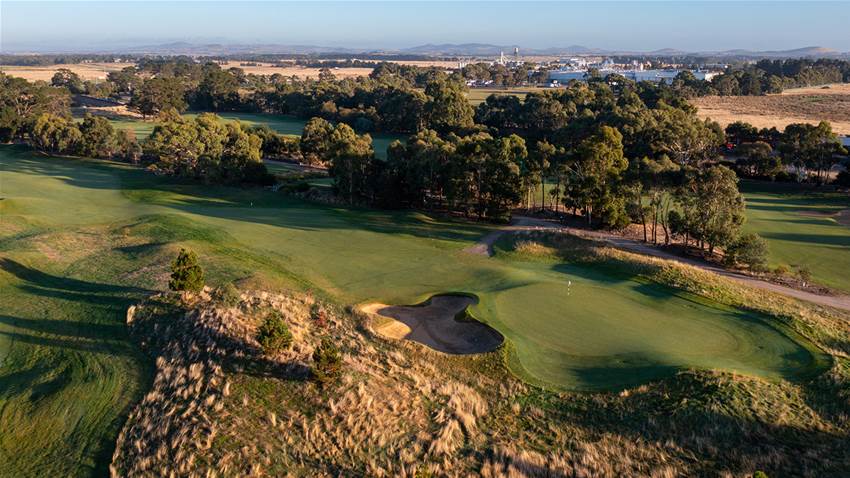There has been no more learned person in Australian golf than the late Peter Thomson.
His articulate observations on the game always had a passion for golf at their heart. No area of the game went unnoticed by the five-time Open Champion.
In particular, his views and theories on course architecture – gleaned over nearly five decades as a course designer – were the foundation of more than 180 designed courses across 30 countries.
One of Thomson’s last Australian designs before his retirement can be found at Ballarat Golf Club – a club that originated in 1895 and remains Australia’s oldest layout still played on part of the original course.
With approval given to a large residential development adjoining the club, Thomson and design partner, Ross Perrett, were commissioned to create an almost completely new course, covering some of the original layout as well as new land adjacent to the property. The result of their work opened for play in 2009 and, almost immediately, gained a position in Australia’s Top-100 Public Access Courses ranking. It has been there ever since.
In 2021, it crept up three places to No.67 in the nationwide ranking.
“Peter Thomson and Ross Perrett’s design at Ballarat is a beauty. Of particular note is the routing with holes playing to all points of the compass, which adds to the variety of shots you play during a round,” said Top-100 ranking panelist, Hamish Walker. “This is a good, fun golf course for all players.”

When asked a few years ago what makes a good golf course, Thomson explained if a course was playable and enjoyable for all golfers it was one worthy of praise.
“Hardly anyone is about making courses more friendly, by giving relief to the less gifted in the form of more mown grass and fewer cavernous craters of sand, or of clearing unnecessary trees within the course boundaries to let in the light and air,” Thomson said.
“If there is an art to golf course design, it is the achievement of making an 18-hole course a source of pleasure to all manner of golfers, from the best among us to the most inept. A course that is so difficult that the highest handicaps can’t finish is a poor course.”

Thomson and Perrett’s work at Ballarat certainly gets a big tick for being a fun, yet challenging, layout for players of all abilities.
This is not a long course by modern standards. It stretches to 6,283 metres from the back pegs (5,817 from the members’ tees), but Thomson and Perrett ensured every club in the bag will get a run during the round and good scores will be born out of thinking smart from tee to green.
The designers haven’t taken the driver completely out of the hands of players but – with the strategic positioning of bunkers, rough or water – they leave you open to the suggestion of a better option. Smart play is always rewarded here, where poorly executed aggressive play is penalised.
Adding to the challenge of playing this design is one constant – wind. There always seems to be a breeze here, which adds to the variety of shots you will have to play, especially when you consider all holes have been routed to run to all points of the compass.

Of note, though, is the great collection of short par-4 holes. The first of these is the 319-metre par-4 3rd, which plays slightly downhill from the tee and is flanked by out-of-bounds to the left for its entire length. The rough-covered mounds down the right cut
into the fairway, creating a wide tongue of rough that has been filled with a bunker, about 240 metres from the back tee. The best approach to the shallow green is from the right half of the fairway so players are left with two playing line options – play short of the fairway trap and make a longer approach, or be aggressive and bomb a drive over the left edge of the bunker and leave a short iron into the putting surface.
The following hole, a 358-metre par-4, is also worthy of mention here. It only plays about 40 metres longer than the 3rd hole but it is a far more demanding offering with water, sand and two majestic gum trees providing the defense of par. The fairway gently rises and falls over waves of small hills and narrows significantly as it squeezes past a sole bunker cut in from the right rough and lying right in the driving zone. The two gums, while wide of the fairway, can block out any approach that veers too wide of being in the centre of the fairway. The best line into the green is from the right half of the fairway, which features plenty of mounds and hollows, making a flat lie quite rare. There are no greenside bunkers, as the green is slightly elevated, with water left and swales to the right.
Another hole that is a tough proposition and demands smart play instead of brutish hitting opens the back nine. The 471-metre 10th hole could be considered a short par-5 by modern design standards but it is a genuine three-shot par-5 for most players. The out-of-bounds well left of the fairway is not of primary concern to players here … keeping your ball dry on the journey to the green is the real worry.

The first of two creek crossings is just 240 metres (it’s about a 260-metre carry from the back pegs) from the tee, which means any player with sights on reaching the green in two blows needs to be as close to this water as possible. This is a tough ask as the fairway starts sloping down to the water’s edge from about the 220-metre mark. By far the best approach into the angled-right green is from the left half of the fairway. If, like me, you can’t possibly hit two shots nearly half a kilometre, it’s best to lay up left (well away from the lake that lines the right edge of the fairway) and short of the second ‘burn’. This, however, brings a large fairway bunker on the left edge of the fairway into play. Avoid the sand and you will be left with an 8- or 9-iron or even a wedge (depending on the pin position on the massive green) for your third shot.
The club recently began a program of remodeling its bunkers using a new bunker lining, called Golflex, which turns end-of-life tyres into a crumb rubber, creating a more porous, hard-wearing and flexible bunker lining.
“It basically keeps the bunker shape, drains it and there’s less maintenance, especially after heavy rain,” General Manager Lloyd Miller said. “There’s also more consistency from bunker-to-bunker.
“We also have a variety of different sands being used at the moment, but this program will see all the same sand used, all from one supplier, across the course.”

I have been fortunate enough to play Ballarat several times since it officially re-opened more than a dozen years ago and it has matured nicely beyond the usual ‘honeymoon’ period for a new course, particularly in terms of its presentation.
Miller paid tribute to Ballarat greens staff, led by course superintendent Jeff Powell, for the outstanding work they do in keeping the layout at such a high standard of conditioning.
“For the man power we have, the amount of playing traffic and the budget Jeff has got, he does a fantastic job,” Miller said.
“He’s passing on that knowledge too. He’s had two guys win apprentice of the year, in back-to-back years, and that’s a credit to him for his ability to teach them. And, ultimately, the proof is out there on the golf course.”
Given the climatic extremes that can be experienced in Ballarat from the depths of winter through to the highs of summer, the playing surfaces have adapted beautifully to their environment … which ticks another box as far as Thomson is concerned when it comes to producing a course of integrity.
“As for golf courses of integrity, I know this is an unusual word, but to me, it means strength of features, proper dimensions, which give an obvious look of a golf course, not too many trees, but enough for the enhancement of bird life and habitat without interfering too much with the golf,” Thomson once said. “Add to this a high standard of maintenance, which may well be the most important thing of all.”
FACT FILE
 LOCATION: Sturt St, West Ballarat.
LOCATION: Sturt St, West Ballarat.
CONTACT: (03) 5338 3000
WEBSITE: www.ballaratgolfclub.com.au
DESIGNERS: Peter Thomson & Ross Perrett (2009).
PLAYING SURFACES: Santa Ana couch (fairways), G2 bentgrass (greens & surrounds), fine fescues including Sheep’s and Creeping Red (rough).
COURSE SUPERINTENDENT: Jeff Powell.
PGA PROFESSIONALS: David Wallis (head professional), Angela Tatt, Andrew Cartledge, Travis Tatt and Daniel Defelice.
GREEN FEES: $35 (weekdays), $45 (weekends). Carts: $50.
MEMBERSHIPS: Due to unprecedented demand, the club has limited vacancies for it seven-day membership categories. There are other categories available with details and application forms to be found on the club’s website.
ACCOLADES: Ranked No.67 in Golf Australia magazine’s Top-100 Public Access Courses for 2021.
Related Articles

Review: Omaha Beach Golf Club

Course Review: Cape Kidnappers












